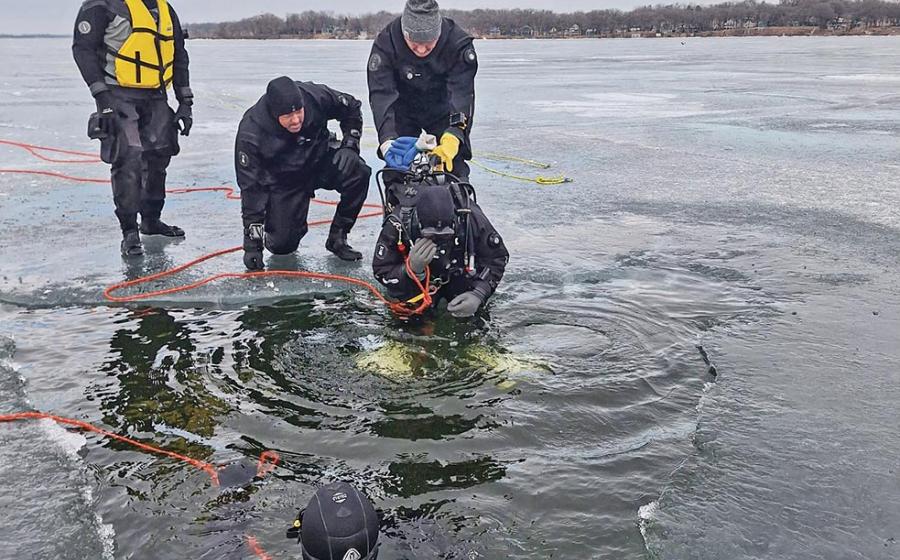Thunder Bay National Marine Sanctuary

By Walt Bonora
A storm considered one of the most devastating to pound the Great Lakes during the twentieth century blew across Lake Huron and past aptly named Thunder Bay near Alpena, Mich., in early November 1913. The storm's hurricane force winds swallowed the steel-hulled freighter Isaac M. Scott, sending the ship to the bottom and her 28 passengers to their deaths. Today, the Scott lies protected on the lakebed within the borders of the Thunder Bay National Marine Sanctuary--and she's not alone. More than 150 shipwrecks litter the bottom of this 448-square-mile protected area off the northeast coast of Michigan's lower peninsula, set aside by Congress in 2000 specifically to protect these historic wrecks.
"Thunder Bay is a museum of the history of Great Lakes shipping" says Joseph Sobczak, owner of Thunder Bay Scuba in Alpena, Mich. "Imagine hovering over the deck of a ship that sunk around the time of Abraham Lincoln's first political speech. History is all around you in these waters."
What attracts divers to this area, beyond the fact that it's an underwater archive of Great Lakes shipping and commerce, is that many of the ships are in pristine condition. Why? Saltwater corrodes. Freshwater protects. And that's what makes this sanctuary unique. Ships like the Grecian--a turtleback freighter that sank in 110 feet of water during a 1906 storm and remains perfectly preserved 100 years later with her windlass, pulleys, side rails, capstan and three anchors still in place--and the Monohansett--one of Thunder Bay's most visited wrecks that, in 16 feet of water, is accessible even to snorkelers--make ideal destinations for divers of all levels who want to experience these living time capsules.
InDepth
The water's cold so bring at least a 7mm wetsuit--or a drysuit--with hood and gloves. A handful of dive charters depart from Alpena, Mich.; rates start at about $95 per diver.
Experience needed: All levels, from beginner to technical diving.
Conditions: Water temperature hovers between 40 and 50 degrees; vis generally ranges from 40 to 70 feet.
Where: Off the northeast coast of Michigan's lower peninsula, near the town of Alpena, Mich.
When: Dive season is May to October, but conditions are best from May to August.
On the Web: Dive operator listings available through Alpena's Chamber of Commerce, alpenacvb.com/scuba-diving-44/; for sanctuary info visit thunderbay.noaa.gov

By Walt Bonora
A storm considered one of the most devastating to pound the Great Lakes during the twentieth century blew across Lake Huron and past aptly named Thunder Bay near Alpena, Mich., in early November 1913. The storm's hurricane force winds swallowed the steel-hulled freighter Isaac M. Scott, sending the ship to the bottom and her 28 passengers to their deaths. Today, the Scott lies protected on the lakebed within the borders of the Thunder Bay National Marine Sanctuary--and she's not alone. More than 150 shipwrecks litter the bottom of this 448-square-mile protected area off the northeast coast of Michigan's lower peninsula, set aside by Congress in 2000 specifically to protect these historic wrecks.
"Thunder Bay is a museum of the history of Great Lakes shipping" says Joseph Sobczak, owner of Thunder Bay Scuba in Alpena, Mich. "Imagine hovering over the deck of a ship that sunk around the time of Abraham Lincoln's first political speech. History is all around you in these waters."
What attracts divers to this area, beyond the fact that it's an underwater archive of Great Lakes shipping and commerce, is that many of the ships are in pristine condition. Why? Saltwater corrodes. Freshwater protects. And that's what makes this sanctuary unique. Ships like the Grecian--a turtleback freighter that sank in 110 feet of water during a 1906 storm and remains perfectly preserved 100 years later with her windlass, pulleys, side rails, capstan and three anchors still in place--and the Monohansett--one of Thunder Bay's most visited wrecks that, in 16 feet of water, is accessible even to snorkelers--make ideal destinations for divers of all levels who want to experience these living time capsules.
InDepth
The water's cold so bring at least a 7mm wetsuit--or a drysuit--with hood and gloves. A handful of dive charters depart from Alpena, Mich.; rates start at about $95 per diver.
Experience needed: All levels, from beginner to technical diving.
Conditions: Water temperature hovers between 40 and 50 degrees; vis generally ranges from 40 to 70 feet.
Where: Off the northeast coast of Michigan's lower peninsula, near the town of Alpena, Mich.
When: Dive season is May to October, but conditions are best from May to August.
On the Web: Dive operator listings available through Alpena's Chamber of Commerce, alpenacvb.com/scuba-diving-44/; for sanctuary info visit thunderbay.noaa.gov










